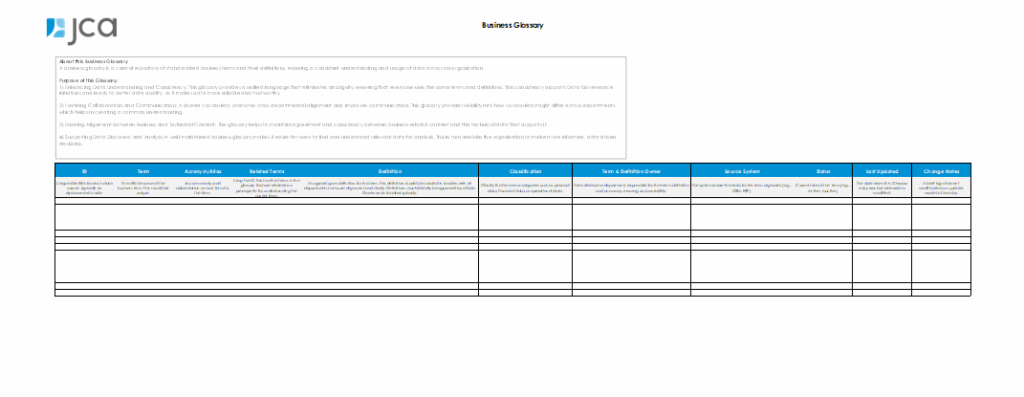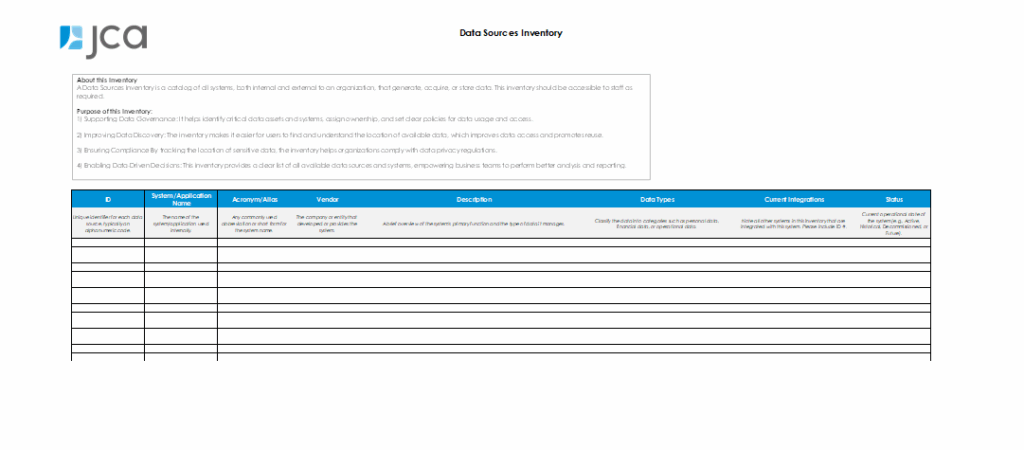Landing Category: Hide from Search
Vivian Advanced User Documentation

Vivian Advanced User Documentation
Vivian Advanced uses Artificial Intelligence (AI) to create seats and revenue forecasts and calculate the optimal single ticket price (dynamic pricing).
Machine Learning (ML) is applied to your historical data for both subscription and single ticket purchases. Similar events at your venue are grouped into clusters, and a tailored model is built for each cluster. These models reflect your organization’s event patterns, producing weekly forecasts that drive daily dynamic pricing recommendations, optimized down to the price point. The more data the ML sees, the smarter it gets. As the models gain more insights from your sales data, their recommendations become more accurate.
Ticket sales drive weekly forecast changes. Ticket prices influence forecasts only slightly, but they play a key role in price optimization. Each time you adjust prices, that new price becomes the baseline for the next day’s recommendations.
Business Impact
Enabling Vivian Advanced gives you access to the AI-generated forecasts for your upcoming productions. These forecasts are updated daily and closely track actual ticket sales, helping you make faster, more confident pricing decisions, without needing to manually select comparators.
Daily dynamic pricing recommendations by zone can guide manual price adjustments or be committed in just a few clicks, streamlining your workflow. By surfacing insights that were previously overlooked or time-consuming to manage manually, Vivian Advanced empowers you to act strategically, accelerating price changes and optimizing revenue potential.
Vivian Advanced Step-by-Step
Enabling AI Forecast
Vivian Advanced defaults to AI Forecast. You can choose between AI Forecast and Comparators Forecast. This choice will determine the values displayed in the Forecasting module and in the Monitoring Dashboard report.
- Select the “Forecasts” icon from the left-hand navigation.
- In the Forecast drawer, locate the Comparators Forecast / AI Forecast toggle to confirm AI Forecast is enabled. Click the toggle to switch between the Comparators and AI Forecast.
- Select your production or individual performance from the Forecasts table. Be sure to select your filters so the table displays.

AI Forecasted Sales Curve
The Forecast drawer is designed to easily choose between Sales and Revenue curves.
1. Select the “Forecasts” icon from the left-hand navigation.
2. In the Forecast drawer, click on Seats or Revenue to change the curve displayed.
3. Select your production or individual performance from the Forecasts table. Be sure to select your filters so the table displays.
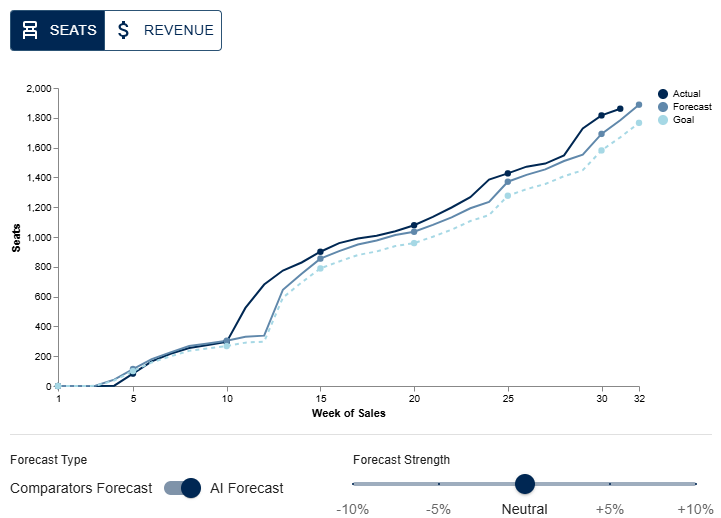
4. Optional: Click the Comparators Forecast / AI Forecast toggle to view Comparators Forecast.
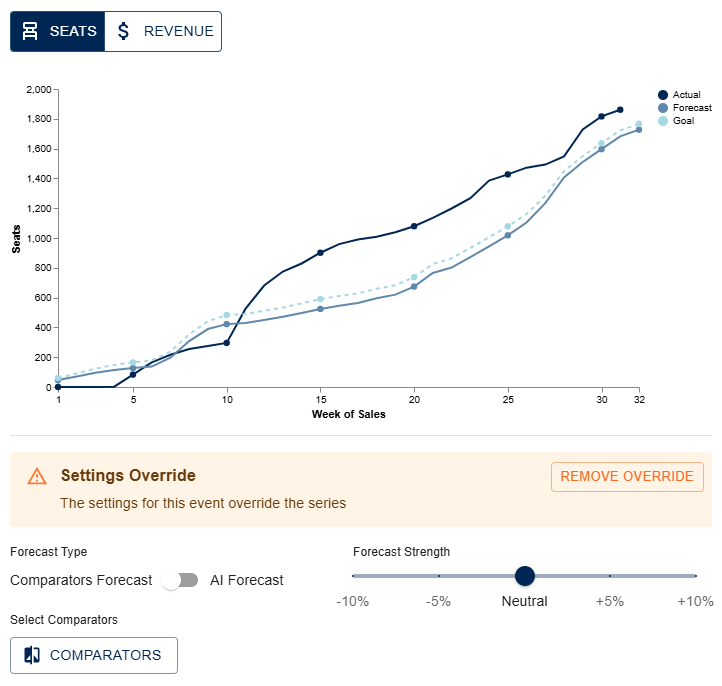
Forecast Strength
To manually adjust the forecast strength to be more or less aggressive, click on the slider that is defaulted to Neutral and drag it to -10%, -5%, +5% or +10%, based on how you want to adjust the forecast. The forecast curve will shift to the new numbers.

Daily Dynamic Pricing
In Vivian Advanced, daily dynamic price recommendations are populated in the “Recommended” column of the dynamic pricing module. To review and apply your daily dynamic price recommendations:
- Select the “Dynamic Pricing” icon from the left-hand navigation.
- Choose a Zone Map from the drop-down menu if you have more than one. Be sure to select your filters so the table displays.
- Click on Accept Recommended.
- Review the prices in the New column for each zone.
- Click on the pencil icon to make manual edits to the prices. Delete the price to keep the current price.
- Commit the new pricing per the current flow.

Reviewing Dynamic Pricing Recommendations
Human oversight and decision-making is integrated into Vivian Advanced’s Dynamic Pricing workflow. When first using Vivian Advanced, review the price recommendations for all your zones by scrolling to the right. You can modify or delete any recommendations that aren’t aligned with your real-world understanding of your performances.


Support
The best way to reach our team for support with Vivian is to email us directly at viviansupport@jcainc.com. Please provide details on your support issue so we can plan a quick resolution.
FAQs
Q: What is Machine Learning?
A: Machine Learning is a subset of AI that enables systems to learn from data and improve their performance over time without being explicitly programmed. Using ML over other types of AI is often preferred when the goal is to learn from data and improve performance automatically.
Q: Why use Artificial Intelligence / Machine Learning to predict event forecasts and dynamic pricing?
A: Machine Learning is well-suited for forecasting and dynamic pricing because it can handle the complexity and scale of ticketing data more effectively than traditional statistical methods. Specifically, ML:
- Captures complex patterns in sales and audience behavior
- Processes large, diverse datasets efficiently
- Adapts to changing trends
- Supports feature engineering
- Enables near real-time forecasting and pricing recommendations
Q: What ML does Vivian use?
A: Vivian is using both unsupervised and supervised learning for the Vivian ML pipelines. Unsupervised learning is used to cluster events together, similar to the manual comparator selection process, but automated. Supervised learning is then used to produce forecasts for each of those clusters, based on knowledge of the previously sold events in each cluster.
Q: What data are used in Vivian Advanced?
A: More than 10 key event characteristics, including zone map, seat map, performance type, time of day, day of week, month of year, week of run, order (show) within the run, facility, capacity, and sales are used for Vivian Advanced AI. All analysis is based solely on your organization’s data—no outside sources are used—so recommendations reflect your venue’s unique patterns and audience behavior.
Q: What does the clustering of my performances look like?
A: Some clusters will have as few as two performances, meaning they are unique. The optimal number of clusters is between five and ten, but there can be a need for more clusters for many unique performances, and it’s expected that subscriptions and single tickets will have a different number of clusters.
Q: How do the models create my forecast curves?
A: The model predicts price points and aggregates them for subscriptions and single tickets.
Q: How are my daily price recommendations calculated?
A: Every night the Daily Update pipeline runs and any new events are then classified into the existing clusters. The price recommendations in Vivian get overwritten daily, so you see new fresh data based on your current performances. Vivian Advanced applies rules to limit extreme price changes, and any recommendation that exceeds the minimum or maximum thresholds is automatically adjusted to remain within those bounds.
Q: Why don’t some performances have forecast data?
A: Ensure you are looking at future performances, since forecasting is about what will happen in the future. Also, Vivian gets nightly updates of your data from Tessitura, and with all data management, regular work is required to ensure data quality and resolve expected data errors that could affect forecast or price recommendations.

Q: How do we know the ML models are making good predictions?
A: Models are evaluated through a combination of evaluation techniques, validation strategies, and interpretability tools. For Vivian Advanced, the forecast prototype models were evaluated using the mean-squared error (MSE) metric, which evaluated the type of model that would be best (XGBoost).
Data Governance Template Review
Data Governance Template Review
You’ve started the journey, but turning templates into a valuable, working data governance framework can be a challenge.
Let us help. Enter your details below for a complimentary review of your templates, and we’ll show you how to maximize your results.
If you’re not sure how to use these resources, we can help with that, too.
"*" indicates required fields
Data Governance Templates

Download Your Data Governance Templates
We know that effective data governance starts with a clear understanding of your data landscape. We’ve created three go-to documents—a Business Glossary, a Data Sources Inventory, and a Data Quality Issues Log—to help you enhance data quality, improve collaboration, and make more informed decisions. Each document is a powerful tool on its own, and together, they are designed to form a strong foundation for managing your organization’s data.

Let’s Get Started
These documents are designed to be a practical starting point for your data governance journey. We encourage you to download and use them to begin building a more trusted and reliable data environment.
Business Glossary
The Business Glossary provides a unified, authoritative dictionary for all of your organization’s terms. This ensures everyone, from development to program staff, is using the same language. For example, if your fundraising team defines a “donor” as anyone who has given in the last two years, but your community giving team only includes those who’ve given over a certain amount, their numbers and messaging won’t align. By standardizing these terms, the glossary eliminates confusion and improves communication and data consistency.
Data Sources Inventory
The Data Sources Inventory is a comprehensive map of where your data lives. It catalogs all the systems—like your donor management, volunteer, or program tracking databases—that create or store data. This is crucial for data discovery and demonstrating accountability. If your organization needs to identify all systems containing sensitive donor information to ensure privacy, the inventory provides a quick and accurate reference, building trust and helping to meet compliance requirements.
Data Quality Issues Log
The Data Quality Issues Log is a dynamic tracker for every data problem. It helps your organization move from a reactive approach to a proactive one by documenting, managing, and resolving data issues systematically. When a Major Gift officer notices incorrect figures on their pipeline report, they can log the problem here. This allows the organization to track and prioritize the issue, understand and fix the root cause, and prevent it from recurring.
We’re here to help!
Whether you have feedback on the templates or need expert support building your data governance strategy, our team is ready to assist. Don’t hesitate to reach out to us here or at smarter@jcainc.com.
Trends in Audience Behavior: What’s Changed in 2025?
Thank you for requesting our study, “Trends in Audience Behavior: What’s Changed in 2025?
Please check your email for access, or read the study by clicking on the button below.
Your Data Personality: The Data Strategist
Your Data Personality: The Data Strategist
Data Strategist, you’ve built an empire of insights and know how to leverage every piece of information to your advantage. Your unique perspective is your superpower. You’re skillfully weaving data into the fabric of your fundraising plans, making informed decisions that drive real results. Your data program is robust, likely encompassing a solid range of analytics and reporting. You’re constantly thinking three steps ahead, noting strategic trends, and acting on what others see as just numbers.
A bit of perfectionist (maybe…), you are meticulous, detail-oriented, and have a plan for everything. Your commitment to accuracy and depth ensures your data is not just collected but truly meaningful. At the same time, you know not to let perfection stand in the way of progress—you’re agile and ingenious, making the most of limited resources to keep moving forward.
What’s next and where do you need help? Great data management is a marathon, not a sprint—there’s always room to improve and refine. Keep evaluating your data quality regularly to maintain accuracy and usefulness, adapting as new challenges and curveballs come your way. Don’t hesitate to consider purging records that no longer add value—clean data is the foundation for clear insights and stronger decisions.
To become an absolute data icon and fundraiser BFF, explore predictive analytics to anticipate donor behavior, optimize your gift pipelines, and refine your stewardship efforts based on deep insights.
Remember, even the most brilliant data strategies and cutting-edge tools won’t reach their full potential unless the people around you are on board. Effective change management means communicating clearly, involving your team early, and providing the training and support they need to embrace new systems and processes. Bringing everyone along ensures smoother transitions and stronger, lasting success for your data program.
You’re already making great strides; now it’s about perfecting your strategic data advantage! Need a partner to help guide the way? – we’ve got you covered!
Ready to go to mega heights? Check out the resources below and talk with our JCA team!
Share this quiz with a colleague and compare your results!Your Data Personality: The Data Navigator
Your Data Personality: The Data Navigator
Oh, Data Navigator, you are the Gandalf of the operations team—you know the way, you understand the terrain, and you’ve seen the dangers lurking in the “shadows” of bad data. Your friends know they can count on you to guide them through any decision, whether it’s planning a big adventure or deciding what to order when everyone’s hungry.
Your ability to chart a course is a true asset. You’re actively using data to guide some of your fundraising decisions, and that’s a fantastic start. Your current data program likely covers essential metrics and some basic analysis with a few hiccups here and there. Your aura calmly quips “My reports are only as good as the data you put in the system.”
To really steer your efforts to the next level, prioritize solid data management and governance to ensure accuracy and trustworthiness. Dive deeper into donor behavior by effectively segmenting your audiences and identifying meaningful trends. Using well-governed, organized data to personalize your outreach will help you connect more authentically and drive better results. With these refinements in place, you’ll be charting even more successful fundraising courses.
A technology roadmap can serve as your own map of Middle-earth, a guiding chart that helps you navigate the twists and turns of your data journey. Just as the Fellowship relied on maps to find the safest and most effective paths, your roadmap keeps your team aligned, focused, and moving steadily toward your ultimate goals.
Bringing your team together and aligning your efforts will forge a powerful force for your fundraising quest. When everyone is on the same page—sharing insights, speaking the same data language, and pulling in the same direction—you’ll move forward with the strength and clarity of the Fellowship marching toward Mordor. Remember, even the smallest hobbit’s steps make a difference when taken together.
What’s next and where do you need help? Even though you’ve proven you are a capable leader, we’re here for you! Whether it’s charting your course for ongoing improvement, assisting with complex data transformations or aligning your teams around new processes or applications – we’ve got you covered!
Ready to embark on a fantastic data journey? Check out the resources below and talk with our JCA team!
Share this quiz with a colleague and compare your results!Your Data Personality: The Data Discoverer
Your Data Personality: The Data Discoverer
You, the Data Discoverer, are the super “true crime” podcast listener. You are always on the hunt for a hidden pattern, a missing link, or a piece of evidence that everyone else may have overlooked. You’re the master of spreadsheets, connecting the dots of a data set that seems “just a little bit sus.”
You’re just beginning to unearth the power of data in your fundraising efforts, and that’s exciting! Think of yourself as a Data Discoverer, with a vast landscape of potential yet to explore. And speaking of exploring, take a second for yourself to start researching that trip to Greece you’ve been dreaming about…you OWE it to yourself (we promise).
You are part of a bigger data ecosystem and your environment matters. Your current data program is likely in its foundational stages, focusing on basic record-keeping. You may be struggling to fully flex your data muscles because your legacy systems make working with data time consuming and highly manual (we are sorry!).
To elevate your impact, consider exploring how to track your most critical data points more systematically. Whether you’re already segmenting your audiences or just starting out, refining this approach—along with small steps like cleaning and organizing your data for better accuracy—can lead to more targeted communications. Small steps in data utilization can lead to significant gains in your fundraising outcomes!
If you’re thinking about replacing your CRM, take the time to assess your current data needs and how the new system can better support them. A thoughtful transition can improve data accuracy, streamline your processes, and empower your team to make more informed decisions. Remember, the goal is to find a tool that fits your unique requirements —not just the latest or most popular option.
What’s next and where do you need help? At this stage of your journey, we’re here for you! We can help you assess your current data landscape so you know exactly where to start and guide you through selecting the right system to fit your needs. Whether it’s strengthening your staffing to handle your day-to-day data deluge, supporting you with data clean-up services, or helping you document processes and procedures for better data management — we’ve got you covered.
Ready to discover more? Check out the resources below and talk with our JCA team!
Share this quiz with a colleague and compare your results!Your Data Personality: The Data Maestro
Your Data Personality: The Data Maestro
You are THE data enthusiast, the hype person. You’re not just working with data; you’re building elaborate, mind-bending projects that captivate everyone’s attention. You turn a simple report into a spectacle, a dashboard into an event. You’re all about the big picture and the even bigger reveal. Bravo, Data Maestro! You are truly orchestrating fundraising success through the sophisticated use of data.
Your data program is not just effective; it’s a finely tuned instrument, providing comprehensive insights that empower you to optimize every aspect of your fundraising. From donor segmentation to campaign performance, your creative energy brings data to life in ways that inspire action and drive results.
Your creative energy is unmatched. It’s time to channel that star power into leading something truly epic and revolutionary for your organization. To maintain your maestro status, continue to innovate by exploring advanced analytics, innovative system efficiencies, and AI Tools.
Artificial Intelligence is your next powerful instrument in the data orchestra. Use AI tools to uncover hidden donor patterns, automate routine tasks like data cleaning and segmentation, and generate predictive insights that help you anticipate giving trends and personalize outreach with laser focus. Explore AI-driven chatbots to engage supporters and apply machine learning to optimize campaign timing. As you experiment, stay mindful of ethical considerations by ensuring transparency, respecting donor privacy, and promoting fairness—building trust and long-term relationships along the way.
To support and elevate your data program, consider exploring graph databases and semantic tools. Graph databases allow you to map and analyze complex relationships between donors, campaigns, and other key data points, unlocking insights that traditional databases might miss. Semantic tools help add context and meaning to your data, making it easier to connect disparate information and generate smarter, more nuanced analytics. Together, these technologies can deepen your understanding and help you tell richer, more impactful fundraising stories.
Remember, even the most brilliant data strategies and cutting-edge tools won’t reach their full potential unless the people around you are on board. Effective change management means communicating clearly, involving your team early, and providing the training and support they need to embrace new systems and processes. Bringing everyone along ensures smoother transitions and stronger, lasting success for your data program.
In short, keep leading the way in data-driven fundraising! The future of fundraising is bright with you at the helm.
What’s next and where do you need help? Whether it’s exploring advanced data storage and reporting solutions, providing extra hands-on support to make your data dreams come alive, guiding effective project and change management, or serving as your trusted thought partner as you embark into uncharted territories – we’ve got you covered!
Check out the resources below and talk with our JCA team!
Share this quiz with a colleague and compare your results!Vivian Feature Focus: Forecasting

Vivian Feature Focus: Forecasting

Today, we want to highlight a new feature in Vivian that we are super excited to see come to life in our clients’ environments—Forecasting!
For those of you who were familiar with the Forecasting Module the RMA, you remember the time investment required to assemble your comparators and create a forecast for an upcoming production. It was a bit of a tedious process! Well, no more with Vivian. In Vivian, you can forecast ticket sales and revenue for both single tickets and subscriptions for a full production season with just a few clicks.
Here is the step-by-step process—with some pro tips—for setting up forecasts in Vivian using the “Comparator Forecast” setting (the “AI Forecast” setting will be coming soon in Vivian Advanced! For now, we’ll focus on Manual forecasts).
1. Pick the production season you want to forecast.
Go to “Season Setup,” click on “Filters” in the upper right-hand corner of the screen. In the slider that pops out, click on “Add Filter,” select “Production Season,” select the production season you want to forecast, click on “apply filters.”
2. Select your Comparators.
Back on the main “Season Setup” screen you’ll now see the production season you selected (in bold) and all its performances. Now it’s time to select the comparators whose sales data you want to use to create a forecast for your production season.
Click on the bolded line for the production season. This will bring you to a Comparators screen. To find comparators and add them to the “Comparator Finder,” click on “filters” and then click on “Add filter” to add the comparators you want to consider. You may add individual production seasons or full seasons. Next, select the seasons or production seasons you want to review, and click “Apply filters.”
Your potential comparators will then show up like this:
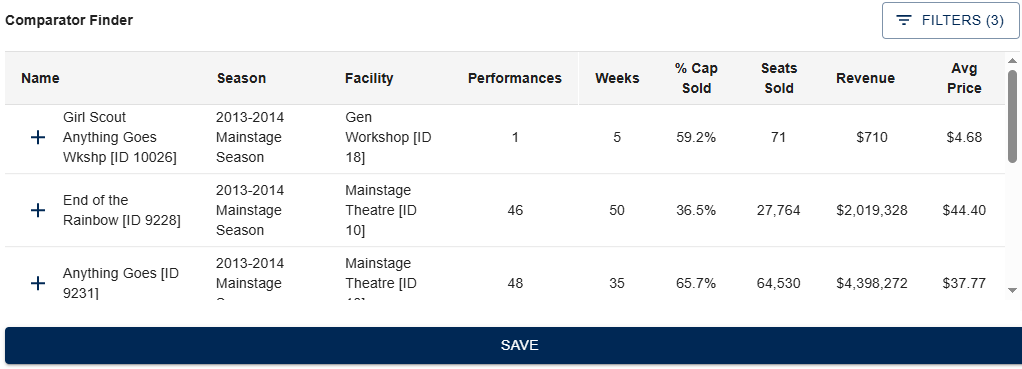
You can use this comparator finder to find shows that performed similarly to how you expect your performance, in this case La Traviata, to perform. You might look for shows that are in the same facility, have a similar number of performances, and have a similar average yield. In the case above I might throw out Sweeney Todd because the Average Price was too low and may sway my forecast, and I’ll also throw out Lydia because it was in a different theatre with a longer run.
You can add comparators to the “Selected Comparators” below (or the comparators you want to use for your forecast) by clicking on the cross to the left of each production season. Once you’re set with your comparators, click “Save.” Vivian will automatically match each of the performances in your comparators to the performances you are forecasting for by Day of Week and Performance Type:

3. Set your Goals.
Now it’s time to set the goals for your ticket sales and revenue for the production season. Remember, your goals are different from your forecast. Your goals are the target numbers that you are aiming to reach with your marketing strategy to meet institutional expectations. Your forecast is where your ticket sales and revenue are likely to end up based on similar historical performances (or, comparators, as we’ve referenced here). Your forecast should, ultimately, inform your goal.
To set your goals, click on the “Goals” button at the top of the page (we’re still in the “Season Setup” screen.) You’ll see existing revenue and seat goals for sub and single tickets. If you use the “budget” line in Tessitura to enter your performance goals, that number will be reflected in the “revenue” numbers. To adjust the goals, click on the bolded production season line. You can then select one of three options in the radio dials:
- Proportionally matching the forecast: If you select this, your goals will match the forecast set with your comparators. So, if a Friday night performance is forecast to sell more tickets than a Wednesday matinee, the Friday night performance will receive a proportionally larger share of the budget than the Wednesday matinee.
- Proportionally matching the current goals: With this selection, Vivian will update any existing goals for each performance so the relationship between each performance’s goals remains the same.
- Equally across events: This selection will give each performance the same goal.
Once you’ve selected the option you prefer, enter the total revenue and seat goals for both subs and single tickets and click “Save Goals.”
4. Review your forecasted sales curve.
Now that you have set your comparators and your goals, let’s go to the “Forecasts” icon in the left-hand navigation. You’ll see, on the right side of the table, your set goals and your forecast—for both the production season in bold and each individual performance (if you don’t see the Production Season in question, you may need to update your filters!). On the left side of the table you’ll see the “End of Week” target— which shows you, using the shape of your forecast as a guide, where you should be at the end of the week to reach your goal—and your actual sales. The arrows indicate if you are trending above or below your goals.
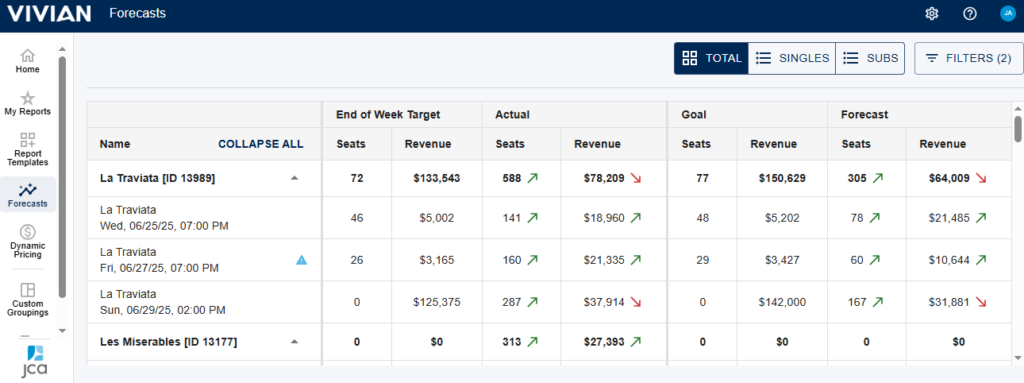
To see your forecasted sales curve for the Production Season, click anywhere on the bolded line at the top. A slider will pop out which will show you a sales curve that includes your actual sales, your forecasted sales, and the sales curve for your goal.
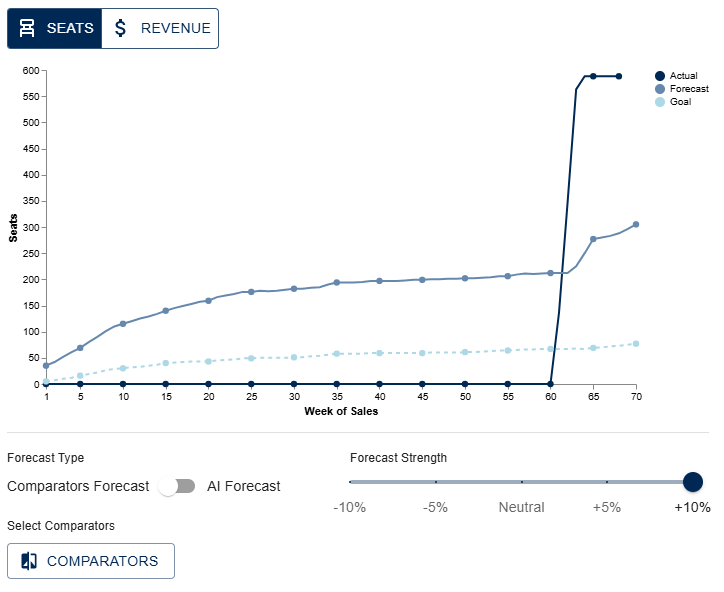
You’ll notice here that you are able to adjust your forecast strength as well. If you want the forecast to be more aggressive, for example, you can increase it by 5% or 10%. If you want to be less aggressive, you can decrease it by 5% or 10%.
At this point you are done creating your forecast! Congratulations! It’s that easy with Vivian, giving you more time to engage with show attendees.
Now let’s see how you can use that forecast in Vivian.
5. Use your forecast in the Monitoring Dashboard.
On your Monitoring Dashboard for the Production Season you just forecasted, you can include a widget to show where your sales are for each performance relative to its forecast and goal.
You can find the Monitoring Dashboard under Report Templates on the left-hand navigation, under “Daily Tracking Reports.” When you create your Monitoring Dashboard, you can go to “View” at the top of the screen and select the “Measures” drop-down to select the measures that use the forecasting data. Those measures are selected in the image below (there are also the same measures for Subscriptions if you scroll down further):
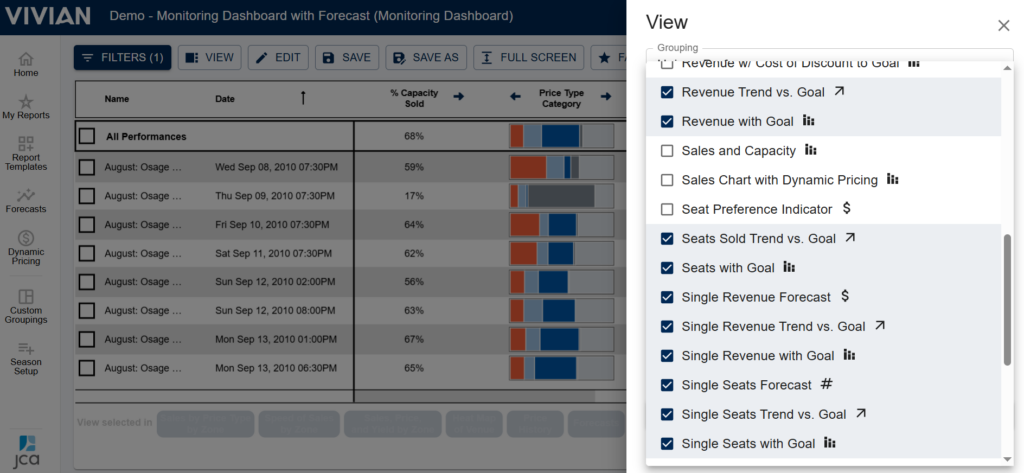
We selected the measures that relate to forecasting and goals for single tickets to add to our Monitoring Dashboard for La Traviata, which look like this:
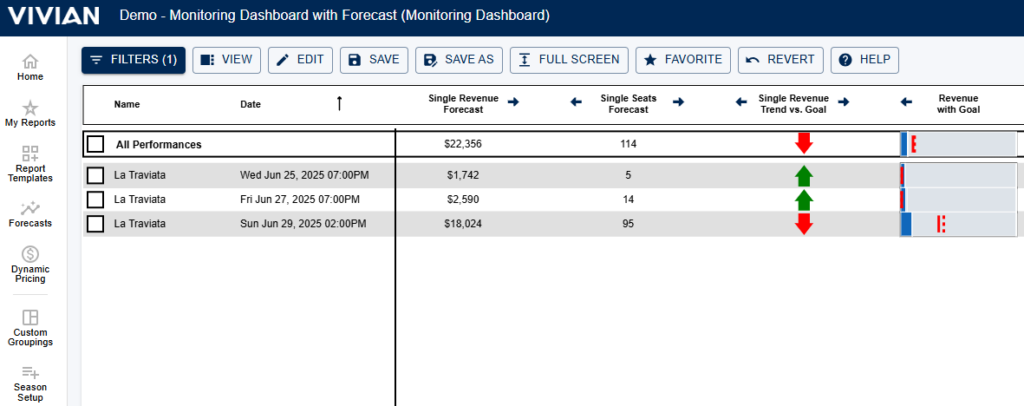
Here is how to interpret these widgets (the widgets featured in the image above and in the details below above are for single tickets, though the related widgets for total revenue and subscription revenue operate the same way):
- Single Revenue Forecast: This is the single ticket revenue the forecast projects the show will bring in.
- Single Seats Forecast: This is the number of single tickets sold that the forecast projects the show will bring in.
- Single Revenue Trend vs. Goal: The arrow shows if your actual revenue is above or below your forecasted revenue trend.
- Single Revenue with Goal: The Blue bar is your actual revenue. The solid red line is your revenue target for this week to meet your goal. The dotted red line is your goal.
There are also “Seats” version of the last two widgets listed above which can be interpreted similarly, but refer to seats rather than revenue. Use these widgets in the dashboard for a quick view of how each performance is performing against its goal.
6. Use your forecast in Dynamic Pricing.
In the Dynamic Pricing module (which you’ll access on the left-hand navigation of your screen), you can also use your forecast for a quick reference as to how each production is performing as you’re making dynamic pricing decisions. Here’s how:
Once you’re in the Dynamic Pricing screen, select a production you have already created a forecast for under “Filter.” Once the screen populates, you can click on the r the individual performances and a slider will pop out on the right-hand of the screen that shows you the forecast for that production season or performance. You can use that as quick reference as you make dynamic pricing decisions!
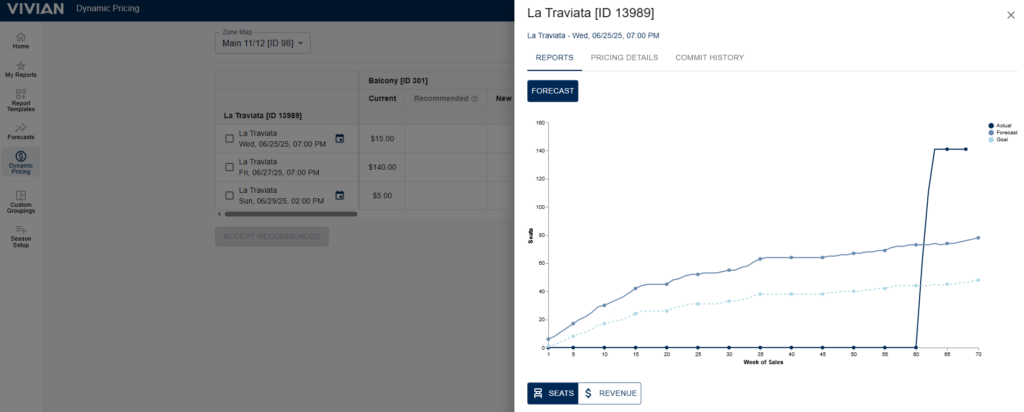
That’s it! You now have a forecast you can use in several areas of Vivian to advance your revenue management strategy. If you have any questions about creating forecasts, let us know! Contact us at viviansupport@jcainc.com.
In Vivian Advanced, creating forecasts will be even easier. Scheduled to go live soon, Vivian Advanced has an “Auto” forecast option which will use machine learning to create a forecast for your shows in Tessitura automatically—no manual entry on comparators required! We’ll share another Feature Focus article on Auto Forecasts as soon as Vivian Advanced is released.


